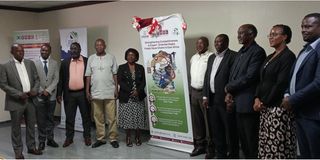Shs7b project to boost grain trade in East Africa

The stakeholders at the launch of the grain project in Kampala on April 5, 2024. PHOTO | MICHAEL AGABA
What you need to know:
- Dr Joshua Mutambi, the commissioner for processing and marketing in the Ministry of Trade and Cooperatives, said Uganda’s grain exports currently stand at around $500 million annually and the new project would help improve it.
The Eastern Africa Grain Council (EAGC) in association with TradeMark Africa have unveiled a three-year project that is aimed at facilitating trade in staple grains such as maize in the East African region.
Titled “Strengthening Competitiveness in Export-Oriented Staple Food Value Chains in East Africa,” the $2 million (about Shs7.6 billion) project seeks to address various challenges in the grain production chain such as inadequate aggregation, informal trading practices, inadequate storage facilities, and a lack of post-harvest handling expertise.
Speaking at the launch of the programme in Kampala on Friday, Mr Gerald Masila, the Executive Director at the Eastern African Grain Council, said the project aims at mobilising, training and equipping farmers with skills and the necessary technologies to join the grain trade chain.
“In this programme, we are going to address the various challenges that make it difficult for export of staple foods, one of them being the issue of aggregation to be able to aggregate sufficient quantities,” Mr Masila said.
“Secondly, is the issue of quality where we will address the quality standards, aflatoxin and other mycotoxin issues, to ensure that production is done using technologies such as aflasafe and others that address the aflatoxin situations, but also the handling of the grain from the farm to the storage and all through to the market so that it is not contaminated when it is in route to market,” he added.
Mr Masila added that they will also be providing solutions around trade finance.
“One of the challenges that is making difficult for farmer groups and SMEs in Uganda to export in the region is the lack of trade finance where they need finance to be able to aggregate pay off the farmers and trade out their products. We will through this project also be preserving jobs and creating more employment from the export-oriented trade that is going to be addressed,” he added.
Dr Joshua Mutambi, the commissioner for processing and marketing in the Ministry of Trade and Cooperatives, said Uganda’s grain exports currently stand at around $500 million annually and the new project would help improve it.
“This project is very timely because now we know that the Uganda is favored by the climate whereby we have two seasons in a year but we have been having challenges accessing markets and this project is going to help the farmers, processors and traders, making sure that they are able to access the market through aggregating, storage and quality control,” he said.
“You are aware that we have the government programs like Emyooga and the Parish Development Model, which are increasing our agricultural production. As you have heard, our production is increasing year by year, which means that we need to add value and be able to access the markets and the farmers especially the challenges, they are facing handling different toxins and all these, so this project has come to make sure that we address this,” he added.
Mr Emmanuel Asiimwe, the country director of the East African Grain Council, said the implementation of grain standards within the region is important.
“But we've been lacking capacity in terms of how best can we support the potential exporters or traders in grain and now with the work we are doing with Trade Africa to make sure that we strengthen the trade in staple foods in the region. One of them is not to do with the quantity only but also the quality,” he said.
“You have seen the incidences where some of the trucks carrying maize to South Sudan were intercepted at the border. And that is mainly to do with the issue of standards,” he added.
Mr Isaiah Langa from Pela Commodities, a grain trading company based in Soroti, welcomed the new partnership.
“At the moment we have got orders in excess of 20,000 metric tonnes of maize, in excess of 6,000 metric tonnes of soybean, in excess of 1,500 metric tonnes of sorghum but we cannot get all this grain because first of all, the production is low and then the quality is poor,” he said.
“So working with the Grain Council of East Africa and Trademark Africa, we are sure that the small cooperatives whom we work with and also farmer groups are going to be able to help to improve on the quality but also on the quantity that we need to meet some of these orders that we have,” he added.
The three-year project is being implemented with funding from the United States government, Feed the Future initiative through the USAID’s Economic Recovery and Reform Activity (ERRA) programme.




